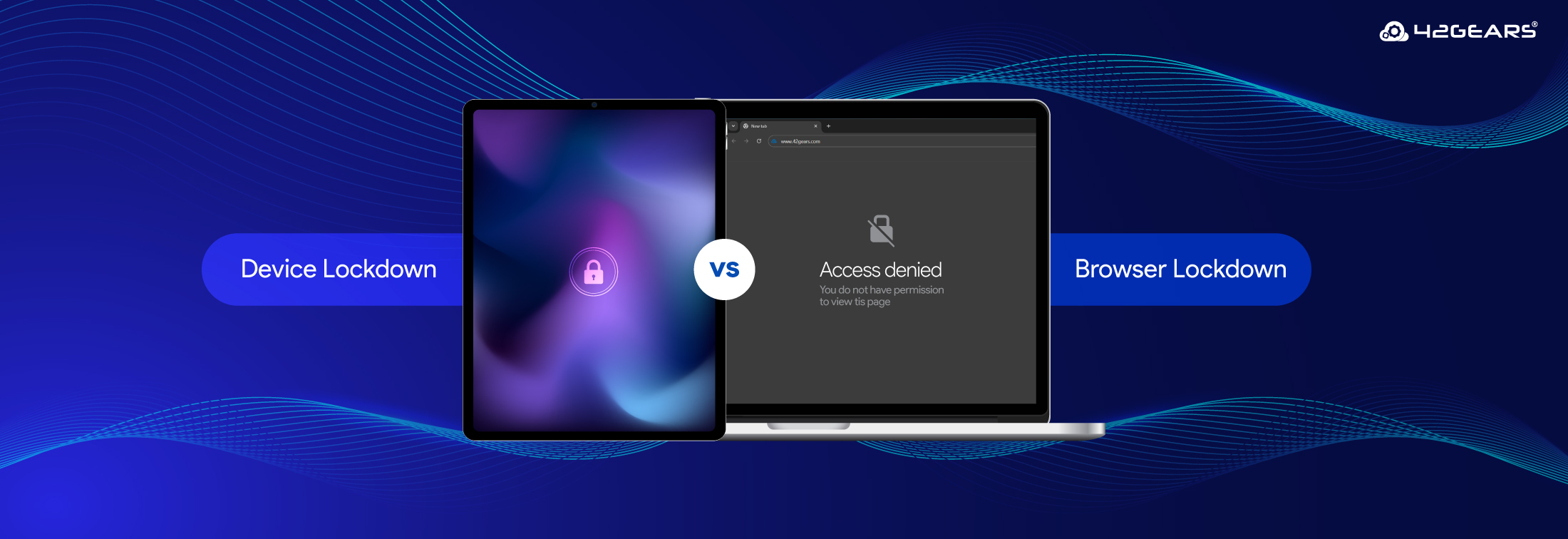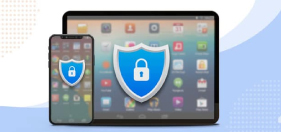Device Lockdown vs. Browser Lockdown: The Latest Guide to Securing Your Business Endpoints
Oct 10, 2025 | Harshita B
Introduction: Device vs. Browser Lockdown in a Hybrid World
Mobile devices are the backbone of modern industry. From the warehouse floor to the customer-facing kiosk, businesses rely on tablets and smartphones to get work done. To ensure these devices are used as intended, companies turn to lockdown solutions. The two most common types are device lockdown and browser lockdown. But with overlapping features, choosing the right one can be a challenge.
A device lockdown solution, often called "kiosk mode," restricts a device to specific apps and settings. A browser lockdown solution limits web access to a pre-approved list of websites. This fundamental difference is just the beginning. This blog explores the market scenario, latest features, benefits, and use cases to help you make an informed decision.
The Booming Kiosk Industry
The demand for dedicated and self-service devices is continuously ascending. Based on industry growth projections, the global interactive kiosk market size is to grow from USD 39.33 billion in 2025 to reach USD 62.68 billion by 20331. This significant growth is fueled by the enterprise-wide adoption of contactless solutions, ensuring enhanced customer experiences, and the constant need for operational efficiency across all sectors.
But this in turn, has created a parallel demand for powerful solutions that can configure, secure, and troubleshoot these kiosks remotely and in bulk. A lockdown solution is no longer a luxury but a core requirement for any successful large-scale kiosk deployment.
Essential Features of a Modern Device Lockdown Solution
Device lockdown has evolved beyond single-app mode. Here’s what to look for:
- Flexible Kiosk Mode: Lock a device to a single app, or a select group of apps. This is ideal for everything from a self-service payment kiosk to a field worker's multi-tool device.
- Remote Management and Provisioning: The rise of remote and hybrid work demands robust remote management. IT admins need to deploy, configure, and troubleshoot devices from anywhere in the world. Look for solutions with zero-touch provisioning and comprehensive remote control.
- Advanced Security Features: In today's threat landscape, security is paramount. Modern device lockdown solutions offer features like:
- Multi-factor authentication (MFA): Secure device access with more than just a password.
- Peripheral control: Disable or enable features like the camera, USB ports, and Bluetooth to prevent data leakage.
- Multi-User and Shared Device Support: For businesses where employees share devices, multi-user profiles are a must. Each user can have their own set of apps and permissions, ensuring data privacy and a personalized experience.
- Analytics and Reporting: Gain insights into device usage, app popularity, and user behavior. This data is invaluable for optimizing workflows and improving the user experience.
Benefits of Device Lockdown (Kiosk Mode)
- Enhanced Security: By restricting access to approved apps and settings, you can significantly reduce the risk of malware, data breaches, and unauthorized access.
- Increased Productivity: When devices are locked to work-specific apps, employees are less likely to be distracted by social media, games, or other non-work-related activities.
- Longer Device Lifespan: Preventing users from tampering with device settings and installing unauthorized apps can reduce wear and tear, extending the life of your hardware.
- Improved User Experience: For customer-facing devices, a simple, intuitive interface is key. Device lockdown ensures a consistent and frustration-free experience.
- Reduced IT Costs: Fewer user-generated issues mean fewer helpdesk tickets and lower maintenance costs.
Top Device Lockdown Use Cases
- Retail: From self-checkout kiosks and price scanners to endless aisle solutions, device lockdown is transforming the retail experience.
- Healthcare: Securely access patient records, streamline check-ins, and provide telehealth services on locked-down tablets and medical devices.
- Field Services and Logistics: Equip your mobile workforce with rugged devices locked to essential apps for navigation, inventory management, and proof of delivery. Driver safety modes can also be enabled to prevent distractions on the road.
- Education: Create a focused learning environment by locking student devices to educational apps and resources. For exams, a single-app kiosk mode prevents cheating.
- Hospitality: Enable self-service check-in/out, provide in-room controls, and offer digital concierge services on dedicated devices.
Essential Features of a Secure Browser Lockdown Solution
Browser lockdown is more than just a website filter. Here’s what it should offer:
- Website Allowlisting and Blocklisting: The core of any browser lockdown solution. Allow access only to pre-approved websites and block everything else.
- Customizable Browser Interface: Create a branded and intuitive browsing experience. Customize the homepage, toolbar, and other elements to match your company's look and feel.
- Advanced Security Settings:
- Disable address bar: Prevent users from navigating to unapproved URLs.
- Control file downloads/uploads: Prevent malicious files from being downloaded and sensitive data from being uploaded.
- Clear cache and cookies on session end: Protect user privacy on shared devices.
- Integration with Identity Providers: For enhanced security, integrate with identity providers to require user authentication before granting access to the browser.
- Content Filtering Analytics: Gain insights into which websites are being accessed most frequently, and identify any attempts to access blocked sites.
Benefits of Browser Lockdown
- Secure Browsing Environment: Protect your network from web-based threats like phishing, malware, and ransomware.
- Prevent Data Leaks: By controlling what can be uploaded and downloaded, you can prevent sensitive corporate data from leaving your network.
- Increase Productivity: Keep employees focused on work-related websites by blocking access to social media, streaming services, and other distractions.
Top Browser Lockdown Use Cases
- Education: Provide students with safe and secure access to online learning resources while blocking inappropriate content and distracting websites.
- Public Access Kiosks: In libraries, government offices, and other public spaces, browser lockdown provides secure web access for visitors.
- Manufacturing and Industrial: On the factory floor, rugged devices can be locked to web-based interfaces for controlling machinery and accessing technical documentation.
- Call Centers and BPOs: In a call center environment, agents can be restricted to CRM and knowledge base websites, ensuring they have the information they need without being distracted.
Device Lockdown vs. Browser Lockdown: How to Choose
The choice between a device and browser lockdown solution comes down to your specific needs:
- Choose a device lockdown solution if: You need to control the entire device experience, including which apps can be used. This is ideal for dedicated-purpose devices like POS systems, inventory scanners, and self-service kiosks.
- Choose a browser lockdown solution if: Your primary concern is controlling web access. This is a good choice for devices that are used for research, online learning, or accessing web-based applications.
- Consider a unified solution if: You need both. Many businesses, especially in education and retail, need to control both app and web access. A comprehensive Unified Endpoint Management (UEM) solution like SureMDM by 42Gears can provide both device and browser lockdown capabilities in a single platform.
Frequently Asked Questions (FAQs)
What is the difference between single-app and multi-app kiosk mode?
Single-app kiosk mode locks a device to a single application. This is ideal for a dedicated-purpose device, like a self-checkout kiosk. Multi-app kiosk mode allows users to access a select group of pre-approved apps. This is useful for devices that serve multiple functions, like a field worker's tablet.
How do I lock down an Android tablet for my business?
Locking down an Android tablet typically involves using a UEM or mobile device management (MDM) solution. These solutions allow you to create a "kiosk mode" policy that restricts the device to specific apps and settings. You can then remotely apply this policy to your fleet of Android devices.
Can I use Browser Lockdown to prevent access to social media?
Yes, that's one of the most common use cases for browser lockdown. By creating a "blocklist" of social media websites, you can prevent users from accessing them on company-owned devices.
Is a device lockdown solution secure?
A well-configured device lockdown solution can significantly enhance security. By restricting the device's functionality, you reduce the attack surface and make it more difficult for unauthorized users to compromise the device. Look for solutions that offer advanced security features like MFA and remote wipe capabilities.
Source: 1. straitsresearch.com
Your All-in-One Lockdown Solution
Why choose between device and browser lockdown when you can have both? SureMDM offers a single, unified platform to lock down devices into kiosk mode and enforce secure browsing policies across your entire device fleet.
Experience the power of both device
and browser lockdown in one unified
platform.
Subscribe for our free newsletter


